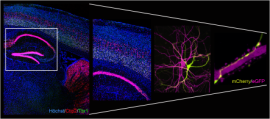Gerald Obermair zum Professor für Physiologie ernannt
Anfang März startete an der KL der Fachbereich Physiologie mit dem Professor für Physiologie, Univ.-Prof. Mag. Dr. Gerald Obermair.

Gerald Obermair (geb. 1973 in Salzburg) hat an der Universität Salzburg und der Bowling Green State University (Ohio) Zoologie und Neurowissenschaften studiert. Nach seiner Dissertation im Bereich der zellulären Neurobiologie an den Universitäten Innsbruck und Salzburg war er an der Medizinischen Universität Innsbruck an der Sektion für Physiologie tätig (Habilitation 2010), seit 2013 als Assoziierter Professor. Gemeinsam mit anderen Wissenschaftlerinnen und Wissenschaftlern ist Obermair Projektleiter im Sonderforschungsbereich „Cell signaling in chronic CNS disorders“.
Im Jahr 2018 konnte er als Sprecher das doc.funds PhD Programm „CavX – Calcium channels in excitable cells“ einwerben.
https://www.uibk.ac.at/pharmazie/pharmakologie/sfb-f44/https://www.i-med.ac.at/mypoint/news/714221.htmlhttps://www.i-med.ac.at/mypoint/news/720543.htmlPreise:Sackler Research Award of the University of Salzburg 1998Sanofi-Aventis Preis 2005
Scientific societies:Austrian Neuroscience Association (Board member from 2012-2016)ANA representative within the FENS governing council (since 2012)Society for Neuroscience
Gutachtertätigkeit:Journals (Auswahl): Biophysical Journal, Cellular and Molecular Life Sciences, Cerebral Cortex, European Journal of Neuroscience, Journal of Neurochemistry, The Journal of Neuroscience, Nature communications, PNAS, Scientific ReportsFunding organizations (Auswahl): ANR (France), APVV (Slovakia), Parkinson’s UK
Journal cover selections:EJN 2004, JBC 2010, JN 2010, JN 2014, JN 2019See https://www.i-med.ac.at/dpmp/physiologie/research/obermair/gallery.htmlhttp://www.jneurosci.org/content/39/14.cover-expansion
Forschungsschwerpunkte:
Untersuchung der vielfältigen Funktionen neuronaler Kalziumkanäle in Muskel und Nervenzellen. Im Speziellen untersucht Obermair die Rolle der einzelnen regulatorischen Kalziumkanalbestandteile in der Bildung und Stabilität von Synapsen in gesunden und erkrankten (z.B. bei Parkinson oder Autismus) Nervenzellen.
Info zu Forschungsgebietenhttps://www.i-med.ac.at/mypoint/news/686749.htmlhttps://www.i-med.ac.at/pr/docs/medinn0117.pdf (Titelseite und Artikel)

Zooming into the mouse brain: From cytoarchitecture to synaptic connections. The two pictures on the left show adult mouse brain sections which were analyzed via labelling of Ctip2 (red), Tbr1 (green) and nuclei (blue). The overview picture on the right illustrates how two hippocampal neurons, transfected with mCherry or eGFP (depicted in yellow and magenta), interact with each other. The detail further demonstrates how a mCherry positive presynaptic nerve terminal forms synaptic contacts along the postsynaptic dendrite of an eGFP positive neighbor neuron.




